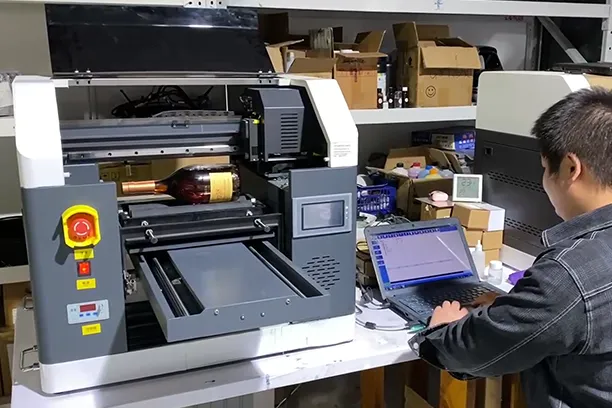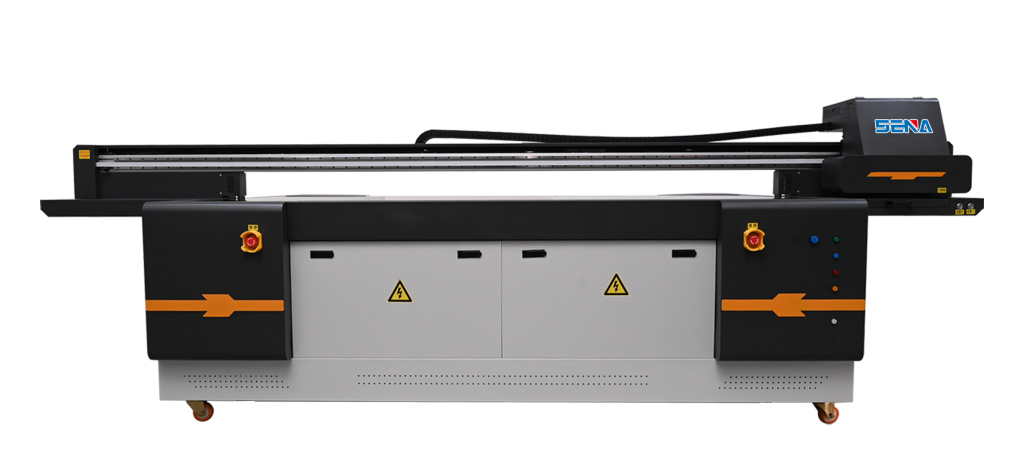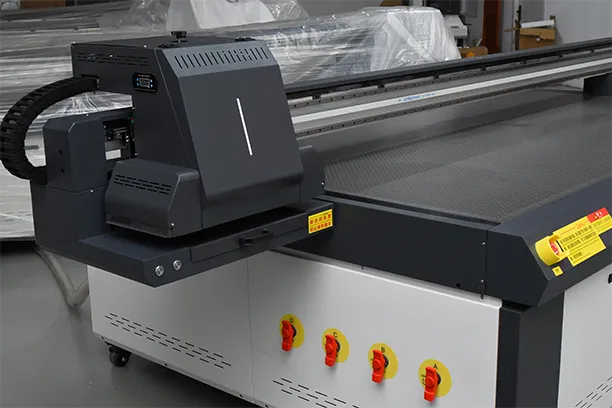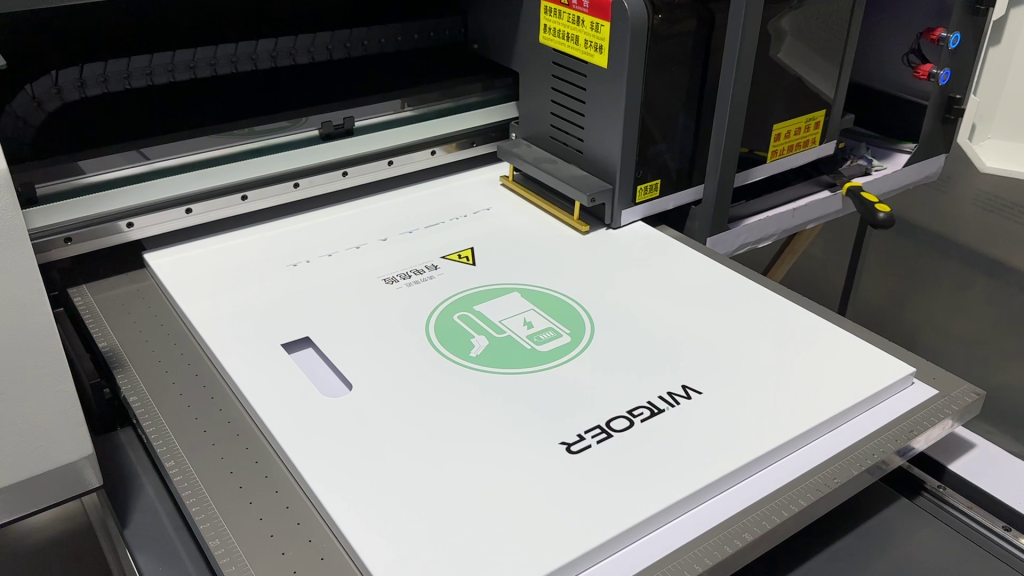Avoid your inquiry is delay response, please enter your WhatsApp/WeChat/Skype along with the message, so we can contact you at the very first time
We will reply you within 24 hours. If for urgent case, please add WhatsApp: +8617888313102, or WeChat: +86 17864107808. Or call +86 17864107808 directly.
*We respect your confidentiality and all information are protected. We will only use your information to respond to your inquiry and will never send unsolicited emails or promotional messages.
Having issues with subpar or unaesthetic prints on differing materials? Missing out on potential profits due to outdated printing technology? Advanced Mechanical offers custom grade printing solutions to meet the goals of any business as a UV Flatbed Printer Manufacturing plant.
Our experienced engineers specialize in designing, constructing and upholding superb UV flatbed and hybrid roll to roll printers. Our proprietary robust printers use specialized UV ink that is instantly cured by UV LED lights. That said, choosing the right supplier from countless competing manufacturers is essential to unlocking unparalleled technology alongside expert-level support tailored to custom industrial grade on-demand printing and laser engraving systems.
Let’s touch base on the essentials. UV printing is a type of digital printing that uses ultra violet (UV) light to cure or dry put ink on a surface almost immediately. In comparison to traditional printing methods, UV printing does not require time for the ink to dry, or if it does, it uses heat instead. After the UV light is applied to the surface, the ink transforms into a strong layer.

This printing technology involves inkjet print heads precisely jetting tiny droplets of liquid UV ink onto a substrate – which could be anything from rigid boards to flexible films. Immediately following the ink deposition, high-intensity UV LED lamps pass over the printed area, initiating a photochemical reaction that solidifies the ink. This means prints are dry and ready for finishing or shipping right off the printer.
As a UV Flatbed Printer Manufacturing plant, we engineer our machines to optimize this process. We focus on the precision of the inkjet system, the efficiency and longevity of the UV LED curing units, and the overall mechanical accuracy of the flatbed printers to ensure consistent, high-resolution output every single time. This technology opens doors for various printing applications previously difficult or impossible to achieve efficiently.
This printing technology involves inkjet print heads precisely jetting tiny droplets of liquid UV ink onto a substrate – which could be anything from rigid boards to flexible films. Immediately following the ink deposition, high-intensity UV LED lamps pass over the printed area, initiating a photochemical reaction that solidifies the ink. This means prints are dry and ready for finishing or shipping right off the printer.

As a UV Flatbed Printer Manufacturing plant, we engineer our machines to optimize this process. We focus on the precision of the inkjet system, the efficiency and longevity of the UV LED curing units, and the overall mechanical accuracy of the flatbed printers to ensure consistent, high-resolution output every single time. This technology opens doors for various printing applications previously difficult or impossible to achieve efficiently.
What are the reasons to select a UV flatbed printer over other printer technologies?
Other forms of printing technology might not compete well with the convenience offered by a UV flatbed printer for businesses that need its versatility. A UV flatbed printer has immense advantages because of the direct printing onto thick rigid substrates like wood, acrylic, glass, metal, and ceramics. Unlike traditional printers that use inkjet technology and have inflexible substrate material, inkjet uv printer use a stationary material so that the printer head assembly can move along the substrate.

What are the reasons to select a uv printing machine over other printer technologies?
Other forms of printing technology might not compete well with the convenience offered by a uv printer machine for businesses that need its versatility. A UV flatbed printer has immense advantages because of the direct printing onto thick rigid substrates like wood, acrylic, glass, metal, and ceramics. Unlike traditional printers that use inkjet technology and have inflexible substrate material, UV flatbed printers use a stationary material so that the printer head assembly can move along the substrate.
This ability serves a transformational role across various business sectors. Custom sign makers will be able to make amazing outdoor advertising signs with non-traditional materials. Custom corrugated board or box printing for packaging factories is also facilitated because they can print directly onto these packaging materials. Wood, glass, and even wallpaper can be printed by home decoration firms. Almost any object can be personalized, which is an advantage gift customization companies can offer. Many different industries can benefit from the use of a UV Flatbed printer because the ink is applied directly to the surface without needing to have special coatings beforehand.
When evaluating a UV flatbed printer, several features stand out, directly impacting performance and usability. These are facets we carefully technology at our factory:

We design our UV flatbed printing machines with these critical components integrated seamlessly, focusing on durability, ease of maintenance, and delivering the print quality and accuracy our clients demand. Understanding these features helps you compare different types of uv printers effectively.
This is where UV printers, particularly UV flatbed printers, truly excel. Their ability to print on an incredibly diverse range of materials is a primary reason for their adoption across so many industries. The UV ink curing process allows adhesion to surfaces where traditional inks would fail.
Here’s a glimpse of the material compatibility:

This versatility means one UV printing machine can serve multiple purposes. An advertising agency can print banners, rigid signs, and promotional products. A packaging company can prototype boxes and print directly onto finished containers. Industrial manufacturers can add durable labels or markings directly onto parts. As a manufacturer of uv printers, we ensure our machines, like the popular A3 uv flatbed printer for smaller items or the large format printer for bigger jobs, have adjustable print head heights and robust vacuum systems precisely to accommodate this wide material range. Our printer can print on substrates up to several inches thick.
The perennial question in any printing operation! UV printers offer a spectrum of print modes that allow users to prioritize either speed or quality, or find a suitable balance between the two. Understanding customer needs and managing client schedules on a case by case basis requires this level of flexibility.
High-Quality/Fine Art Modes: Employ the maximum number of passes, smaller droplets, and slower print head speeds. In intricate graphics, photographic reproductions, and other work involving significant detail and thorough scrutiny, this guarantees the utmost possible resolution, the smoothest gradients, and the most refined details.
Factors influencing this balance include the print head technology, the RIP software’s capabilities, and the UV curing system’s efficiency. As manufactures, we enable advanced operators to generate custom profiles, but we do offer set print modes that can be applied with little to no operator experience. Our large format UV printers are often equipped with multiple rows of print heads specifically to achieve higher speeds without compromising quality significantly. It’s about providing the tools for your print business to choose the optimal setting for each specific job, whether it’s rapid production of promotional products or meticulous varnish printing effects on luxury packaging.
The versatility of UV printing, especially UV flatbed printing, makes it a valuable asset across numerous sectors. We see tremendous success among our clients in these areas:

Essentially, any business needing high-quality, durable digital printing on a variety of materials, especially rigid or unconventional ones, can benefit significantly from investing in a UV printer. The machine can be used for an incredibly broad range of profitable applications.
Selecting a UV printer is a significant investment. Partnering with the right UV printer manufacturer is just as crucial as choosing the machine itself. Your target audience focuses on multiple factors at once, and here is how a reputable manufacturer solves
them:
Beyond these core points, consider the manufacturer’s experience, industry reputation, innovation (e.g., advancements in UV LED technology or ink formulations), and willingness to understand your specific printing needs. Building a relationship with your UV printer manufacturer ensures ongoing success.
The UV printer price can vary significantly based on several factors: size (A3 UV printer vs. large format UV flatbed), speed (number/type of print heads), features (white ink, varnish, roll-to-roll capability), brand reputation, and included support/warranty. A small uv printing machine or desktop UV model might start in the low tens of thousands of dollars, while high-production large format uv printers can cost hundreds of thousands.
It’s crucial to look beyond the initial purchase price and consider the Total Cost of Ownership (TCO) and Return on Investment (ROI). TCO includes the printer cost, ink consumption, energy usage, maintenance, consumables (like UV LED lamps eventually needing replacement), and labor. ROI is calculated by considering the revenue generated through new applications, increased efficiency, reduced outsourcing costs, and higher-value products enabled by the UV printer.
For example, a packaging company investing in a flatbed UV printer might see ROI by:
Similarly, a home decor company using a UV printer for wood or canvas printing can create unique, high-margin products. We, as the printer manufacturer, can help you analyze potential ROI based on your specific business model and the capabilities of our printing machines, like the versatile UV6090 Flatbed UV Printer. Understanding the types of uv printers and their costs relative to their output is key.
The ink and the curing system are the heart of the UV printing process. UV ink isn’t like typical solvent or aqueous inks. It’s a monomer/oligomer mixture with photoinitiators. When exposed to the correct wavelength of UV light, these photoinitiators trigger polymerization, rapidly turning the liquid ink into a solid, durable layer.
Key aspects of UV ink include:
The UV LED curing system is equally critical. Modern LED UV systems offer significant advantages over older mercury vapor lamps:
As a manufacturer, we carefully match our uv flatbed printer with optimized ink formulations and state-of-the-art UV LED curing systems, such as those found in our advanced large format UV Hybrid Printer, to ensure reliable performance and excellent adhesion across the widest possible range of applications, from detailed phone case printing to large-scale industrial printing. The synergy between the inkjet system, the UV ink, and the UV light source defines the final print quality.y combination remains a cornerstone for many businesses due to its rigid media capabilities.
Proper maintenance is crucial for maximizing the lifespan of your UV printer and ensuring consistent print quality. While specific procedures vary by model, some general best practices apply, and reliable manufacturers provide clear guidelines and support.
Daily Checks & Cleaning:
Weekly/Monthly Maintenance:
Preventative Maintenance:
As a UV Flatbed Printer Manufacturing plant, we design our machines for ease of maintenance and provide comprehensive manuals, video tutorials, and technical support. We understand that minimizing downtime is critical for your print business. Our service contracts often include preventative maintenance visits by certified technicians, ensuring your UV flatbed printing machine or digital uv flatbed printer runs optimally for years to come. Think of regular maintenance as protecting your valuable printing equipment investment.
What makes UV printing different from solvent printing?
UV printing uses UV ink that is cured instantly by UV light, allowing printing on a wider variety of materials (especially rigid ones) with sharper details and no drying time. Solvent printing uses inks that evaporate solvents to dry, often requiring specific coated media and releasing more VOCs. UV printing is generally faster for finishing and more environmentally friendly.
How durable are prints made with a UV printer?
UV ink forms a hard, cross-linked layer upon curing, making prints quite durable and resistant to scratches, abrasion, water, and fading from sunlight. Durability varies based on the specific ink formulation, substrate, and environmental exposure, but it’s generally considered excellent for signage, industrial marking, and promotional products. Adding a varnish printing layer can further enhance protection.
Is operating a large format UV flatbed printer difficult?
Modern UV printers come with user-friendly software and automated maintenance features. While there’s a learning curve, reputable manufacturers like us provide comprehensive training covering operation, software (RIP), basic maintenance, and material handling. With proper training, operators can quickly become proficient in managing the digital uv printing machine and achieving high-quality results.
Can UV printers print white ink and varnish?
Yes, many professional UV flatbed printers and hybrid printers are equipped with channels for both white ink and clear varnish. White ink is essential for printing vibrant colors on dark or transparent substrates (glass printing, acrylic). Varnish printing allows for spot gloss, matte finishes, or even textured/embossed effects, adding significant value to prints.
What kind of support can I expect after buying a UV printer from a manufacturer?
As a dedicated UV Flatbed Printer Manufacturing plant, we offer comprehensive support including installation, on-site/remote training, technical phone/email support, readily available spare parts, software updates, and warranty services. Extended service contracts and preventative maintenance plans are often available to ensure maximum uptime and peace of mind for your printing equipment.
How much space do I need for a UV flatbed printer?
Space requirements vary significantly. A small uv printer like an A3 UV printer or desktop uv flatbed printer might fit on a large table or require minimal floor space. A large format UV flatbed printer (e.g., 4×8 ft or larger bed size) requires substantial space for the machine itself, plus clearance around it for loading/unloading materials, maintenance access, and ink storage. Always check the manufacturer’s specifications for footprint and recommended operating space.
Partnering with the right UV Flatbed Printer Manufacturer is crucial for leveraging the power of this versatile printing technology. Remember these key points:
As a dedicated UV Flatbed Printer Manufacturing plant, we are committed to providing not just cutting-edge printing machines, but also the partnership and support you need to thrive. Our range of UV printers, from compact desktop uv models to large format uv flatbed and hybrid uv systems, are designed to meet the demanding needs of businesses like yours.
Ready to explore how our UV printing solutions can elevate your business? Contact us today to discuss your specific printing needs, request print samples, or schedule a demonstration. Let’s unlock new possibilities together.